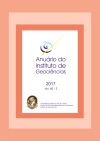Oil Biodegradation in Siliciclastic Reservoir: an Example from Paleogene, Oliva Block, North of Santos Basin, Brazil
DOI:
https://doi.org/10.11137/2017_3_222_231Palavras-chave:
Organic geochemistry, Biomarkers, BiodegradationResumo
For a petroleum company, the oil biodegradation is an important aspect to appraisal both exploration/production and economic perspective. Black to volatile oils require diferent materials and techniques in comparison to those used for heavy oils. Economically, biodegradable oils has a lower market value than the non-biodegradable oil. Following the presence and absence of a set of biomarkers observed in the chromatograms and fragmentograms, it is possible an interpretation and an indentiication of diferent levels of biodegradation . This methodology comprises the main objective of this work. The oil studied lacks “n” and iso-alkanes, the major proportion of tricyclic on the pentacyclic, the presence of demethylated compounds, plus the major proportion of diasteranes on steranes, suggesting an advanced degree of biodegradation. According to this investigation, the degree 8 of biodegradation (Peter & Moldowan, 1993), records a huge process of bacterial attack happened into the reservoir in a range of temperatu e from 350C up to 500C, from the oil/water contact.Downloads
Publicado
2019-07-30
Edição
Seção
Artigos
Licença
Os artigos publicados nesta revista se encontram sob a llicença Creative Commons — Atribuição 4.0 Internacional — CC BY 4.0, que permite o uso, distribuição e reprodução em qualquer meio, contanto que o trabalho original seja devidamente citado.
















 Exceto onde indicado de outra forma, o conteúdo deste site é licenciado sob uma licença
Exceto onde indicado de outra forma, o conteúdo deste site é licenciado sob uma licença 